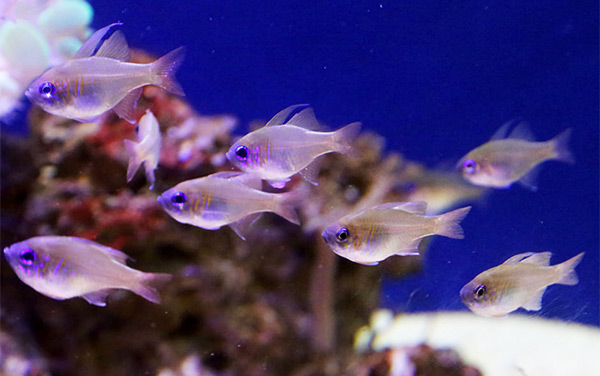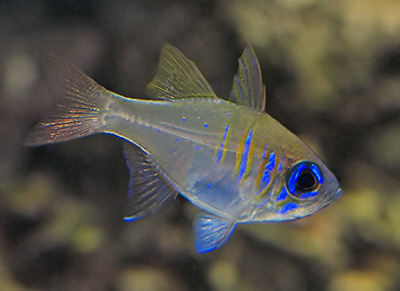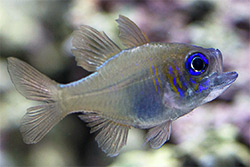Walk by an LFS sales tank containing a few specimens of threadfin cardinalfish (Zoramia leptacantha), and you might not give them a second glance. Chromatically speaking, this species isn’t exactly a showstopper compared to some, especially when viewed in your average LFS environment. But don’t let this cardinal’s unassuming appearance fool you; it can make for an impressive display species when kept in groups.
Physical traits
Z. leptacantha is a diminutive fish, reaching only about 2.5 inches in total length. It’s laterally compressed and has two dorsal fins, the first fairly elongated relative to the second.
As mentioned, this species’ color is nothing to write home about (in case you’re one of those types who like to write home about the colors of fish). It’s semi-transparent to yellowish-silver overall with iridescent blue around the eyes as well as blue and yellow accents on the anterior portion of the body. However, there’s a subtle beauty to this fish that, when kept in aggregate can really add up to a striking visual statement.
Feeding
In nature, Z. leptacantha feeds primarily on small benthic crustaceans. Good alternatives for aquarium specimens include mysids, finely chopped crustacean and mollusk flesh, frozen commercial formulations for small carnivores, high-quality small pellet foods, etc.

Housing
I’ve seen minimum housing recommendations as low as 10 to 20 gallons for this species, but my preference would be to go with a slightly larger tank, say around 30 gallons minimum, so you have the opportunity to keep a decent sized group and observe the species’ natural schooling behavior.
Also, Z. leptacantha is nocturnal by nature, so it’s a good idea to provide a good-sized ledge or cave that the group can refuge under/in during daylight hours, especially in intensely illuminated reef tanks. Aquarium specimens often acclimate to daytime feeding and activity, but the best viewing opportunities might be under more subdued lighting (e.g., moon lighting or transitional lighting mimicking dusk and dawn periods).
Compatibility
Z. leptacantha is a very peaceful species, and any piscine tankmates must be similarly passive. Again, this is a schooling species by nature, and it’s among the few marine species that can—and should—be kept in groups (5 or more) in captivity.
As far as reef-friendliness is concerned, Z. leptacantha is ideal. In nature, this species forms dense aggregations among and above branching stony corals, so a group of these cardinals would make a great addition to a tank full of “sticks.”




